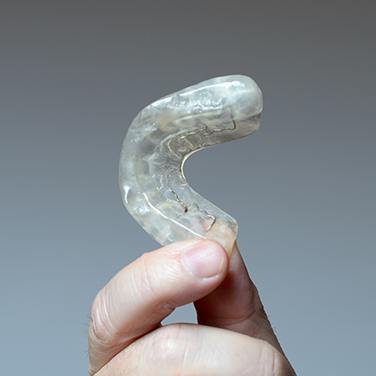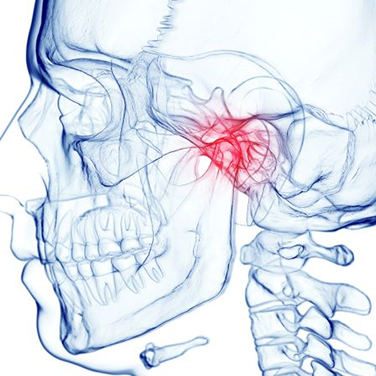
TMJ/TMD Therapy – Wilton Manors, FL
The Answer for Chronic Jaw Pain & Headaches
Does your jaw pop and click every time you move it? Does it feel stiff or ever become stuck while you’re opening or closing your mouth? If so, you may be experiencing a problem with your TMJ, or temporomandibular joint. This is your jaw joint, and if it becomes inflamed, sustains an injury, or isn’t properly aligned, this can easily cause a TMJ disorder, or TMD, leading to all kinds of chronic pain throughout the face and head. If any of these symptoms sound familiar to you, the team at Island City Dental can help find the cause and provide treatments that will deliver the long-term relief you deserve.
Why Choose Island City Dental for TMJ/TMD Therapy?
- Specially-made mouthpieces stop pain & improve jaw function
- All treatments are conservative, noninvasive, & effective
- Able to stop persistent headaches & nighttime teeth grinding
Diagnosis & Treatment

Your TMJ consists of a complicated system of bones, muscles, ligaments, and tendons all working together in order to give your jaw the ability to move freely in all directions. It is an essential part of oral health, so we will examine your TMJ whenever you come to see us for a checkup. If you report or exhibit any signs of a TMD, we’ll perform a few tests and take X-rays of the joint so we can find the underlying problem and figure out how to treat it directly.
Equilibration / Occlusal Adjustments

Often, a TMD is the result of a misaligned bite, in which the orientation of the teeth physically prevents the joint from functioning properly. In order to fix this, we can perform something called an equilibration. This involves adjusting and reshaping a few teeth in order to properly balance the bite. This may consist of slightly shaving down a few teeth and/or building them up with restorations. The end result should be a fully functioning jaw that is also pain-free.
Occlusal Splints

Another way we can help patients dealing with a TMD is to have them wear a therapeutic mouthpiece to bed called an occlusal splint. These fit over the teeth and slightly adjust the jaw into a more natural and functional position, allowing the muscles and nerves to relax and heal. Over time, the jaw will “learn” to stay in this position throughout the day, which should eliminate any pain or dysfunction. These can also help protect the teeth from another common symptom of TMD, nighttime teeth grinding.
TMJ Treatment FAQs

The team at Island City Dental is eager to help you find freedom from the pain and inconvenience associated with TMJ disorder (TMD). But before you book a consultation, you may want to learn more about what to expect on the road ahead. To assist you in your efforts to gather information, we have put together the following list of TMJ treatment FAQs. If your specific questions are not addressed here, give us a call so we can personally speak with you.
Can TMD Be Cured Permanently?
Our goal is always to help patients find long-lasting relief from TMD. Therefore, we offer treatments that strive to address the cause of the problem. For example, an occlusal splint can encourage relaxation of the facial muscles and allow them to recover. Equilibration aims to correct bite problems that contribute to TMD.
Of course, TMD does recur in some patients if they face new injuries or encounter other circumstances that place stress on their TMJ. In many cases, though, patients find that their treatment provides at least semi-permanent results.
Can TMD Be Fixed with Braces?
In some cases, TMD occurs because the teeth and jaws are not well aligned. This misalignment places stress on the TMJ, causing it to hurt and affect nearby muscles. Orthodontic treatment, such as traditional braces or Invisalign, is often able to correct dental misalignment in a way that provides long-lasting relief from TMJ symptoms.
Is TMJ Treatment Safe?
As long as TMJ treatment is carried out by a qualified medical professional, then yes, the process is considered to be very safe. There are minimal risks associated with the treatments we offer because they are both conservative and non-invasive.
In extreme cases of TMD, we may need to refer patients to a qualified specialist who can perform surgery. Surgery carries more risks than noninvasive treatment options, but again, as long as the person doing the procedure is well-qualified, there is only a very small chance that something will go wrong.
How Long Does TMJ Treatment Take?
The timeline for TMJ treatment depends on the specific methods that are used in each case. For example, equilibration often brings very fast relief because it addresses the bite problems that were placing stress on the TMJ. With an occlusal splint, it can be a few weeks to a few months before the results become obvious. If you require orthodontic treatment, it may take several months to a year or longer to complete your treatment.
If you are facing a longer-term treatment, we may recommend that you use at-home remedies to experience pain relief while you are waiting for the cause of your TMD to be fixed. For example, using heat/cold therapy, eating a soft diet, and performing certain exercises may be helpful.